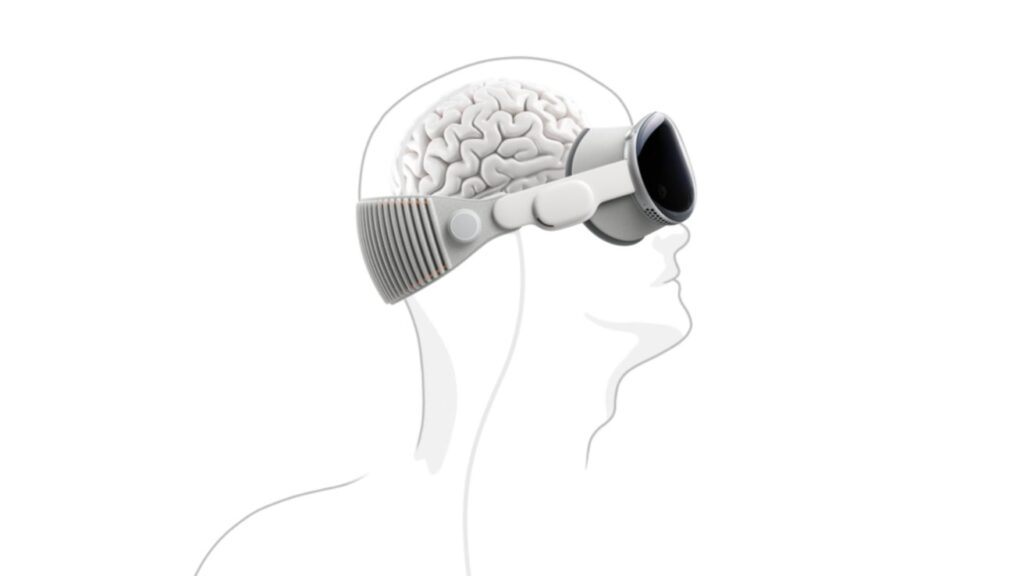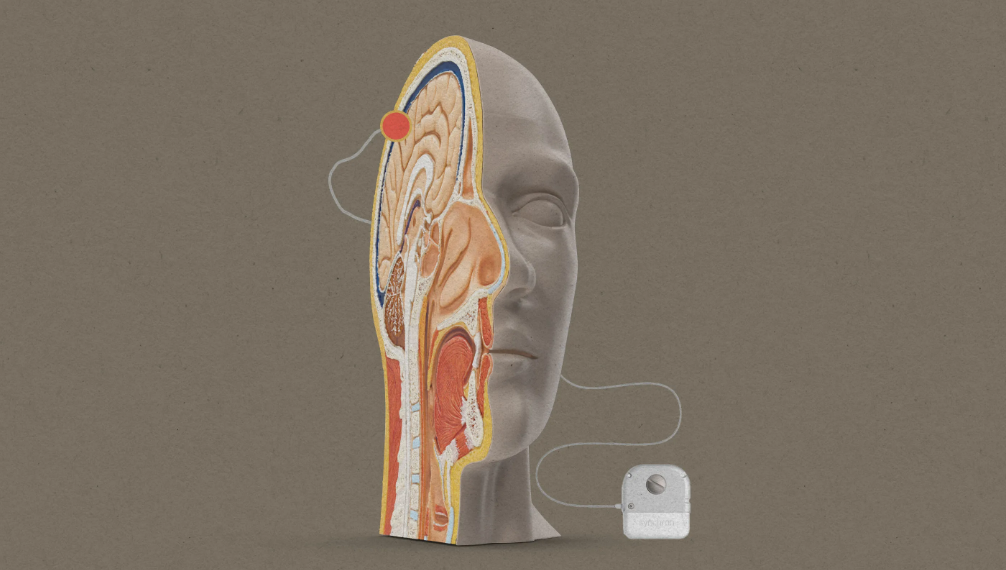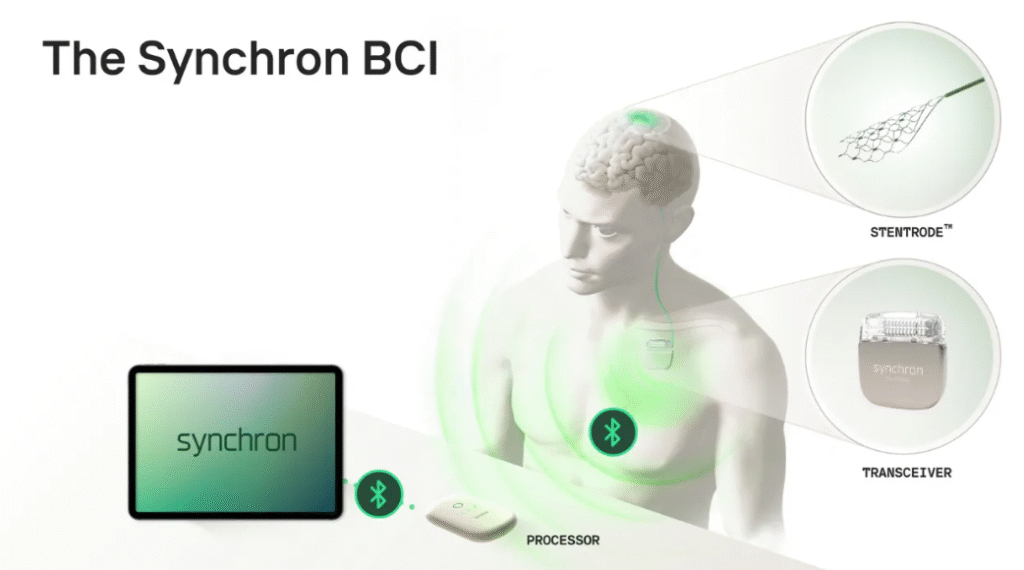Introduction
Imagine controlling your iPhone, iPad, or even a VR headset with nothing but your thoughts. Thanks to a groundbreaking collaboration between Apple and neurotech startup Synchron, that future is rapidly becoming a reality. The two tech giants are working together on a brain-computer interface (BCI) that allows people with severe physical disabilities—such as those affected by ALS or paralysis—to interact with their devices using only their minds.
At the heart of this innovation is Synchron’s Stentrode implant, a minimally invasive device that detects brain signals linked to intention. Early clinical trials show that users can send texts, browse apps, and even control digital environments through thought alone.
This partnership represents more than just a technological advancement. It marks a shift toward truly accessible computing, blending AI, neuroscience, and hardware innovation. In this article, we explore how Apple’s involvement may fast-track BCI into the mainstream, what makes Synchron’s approach different, and why this could revolutionize both assistive technology and human-device interaction as we know it.
What Is a Brain-Computer Interface (BCI)?
A Brain-Computer Interface (BCI)—also known as a brain-machine interface—is a revolutionary technology that enables direct communication between the brain and an external device, without the need for muscle movement. By capturing brain signals and translating them into digital commands, BCIs make it possible to control devices using only your thoughts.
At its core, a BCI works by detecting electrical signals from the brain, interpreting the user’s intent, and converting that intent into a digital action—like moving a cursor, typing a message, or even navigating a smartphone. These signals are often captured via electrodes placed either on the scalp (non-invasive) or within the brain (invasive), depending on the type of BCI.
Originally developed for medical applications—such as helping people with paralysis or ALS (Amyotrophic Lateral Sclerosis) regain control over communication—BCIs are now expanding into the consumer tech space. Leading companies like Neuralink, Synchron, and now Apple are investing heavily in this field, aiming to make thought-powered devices a mainstream reality.
What sets modern BCIs apart is their focus on usability, safety, and minimal invasiveness. Instead of bulky helmets or dangerous brain surgeries, startups like Synchron are pioneering minimally invasive BCIs that use blood vessels to access the motor cortex, dramatically reducing risk and recovery time.
With the growing integration of AI, machine learning, and wearable technology, brain-computer interfaces are no longer science fiction. They represent a future where accessibility, control, and independence are possible for users of all abilities. As Apple enters the BCI space through its collaboration with Synchron, the possibilities for seamless, mind-controlled smartphones, tablets, and even VR headsets are becoming more real—and more exciting—than ever before.
Meet Synchron: The Startup Behind the Implant
Synchron is a cutting-edge neurotechnology startup that’s quickly becoming a global leader in minimally invasive brain-computer interfaces (BCIs). Founded in 2016 and headquartered in New York, Synchron’s mission is to help people with severe motor impairments regain control over digital devices—using only their thoughts.
What sets Synchron apart is its flagship device: the Stentrode. Unlike traditional BCIs that require open-brain surgery, the Stentrode is implanted via the jugular vein and travels through blood vessels to rest near the motor cortex—the brain area responsible for voluntary movement. This approach, known as endovascular BCI, avoids cutting into brain tissue, significantly reducing risk and recovery time.
Synchron’s technology has already reached significant milestones. It was the first company to receive FDA approval for human trials of an implantable BCI in the U.S., a distinction that gives it a competitive edge over rivals like Neuralink. In Australia, early clinical trials have demonstrated success: patients with conditions like ALS and paralysis have been able to send texts, browse the internet, and control computers hands-free.
Now, with Apple’s backing, Synchron is poised to bring its brain-control platform into the mainstream. The collaboration aims to integrate the Stentrode’s capabilities with iPhones, iPads, and even Apple Vision Pro—bridging the gap between medical-grade implants and consumer technology.
Synchron’s innovation marks a turning point in accessibility, empowering users with disabilities to interact with their digital world naturally, intuitively, and independently—simply by thinking.
Apple’s Role: From Accessibility to Innovation
Apple has long been a pioneer in designing technology that is inclusive and user-friendly, particularly for users with disabilities. Features like VoiceOver, AssistiveTouch, and Switch Control have made iPhones and iPads more accessible than ever. But with its partnership with Synchron, Apple is taking accessibility to an entirely new level—moving from touch-based controls to thought-based interaction.
Apple’s collaboration with Synchron is rooted in its vision to make hands-free, brain-controlled devices a practical reality. By integrating Synchron’s Stentrode implant with Apple’s hardware and software ecosystem, the company is exploring how people with paralysis, ALS, or other mobility challenges can fully operate their iPhones, iPads, or even Apple Vision Pro—without lifting a finger.
This initiative isn’t just a medical breakthrough; it’s also a bold leap in human-computer interaction. Instead of relying on external sensors or eye-tracking, Apple aims to build a system that understands user intent directly from brain signals. Imagine thinking about opening an app, composing a message, or navigating a VR space—and watching it happen in real-time.

The project is still in development, but early trials are promising. In one case, a patient with ALS was able to browse the web, text, and interact with VR content using just the BCI implant and an Apple device. Although not yet as fast as standard controls, this advancement opens up a future where mental effort replaces physical touch.
Apple’s investment in brain-computer interface technology is not just about innovation; it’s about empowerment, accessibility, and pushing the boundaries of what technology can do to improve lives.
How It Works: The Science behind Thought Control
The idea of controlling a smartphone with your mind may sound like science fiction, but with Apple and Synchron’s new brain-computer interface (BCI) technology, it’s quickly becoming reality. At the core of this breakthrough is the Stentrode implant—Synchron’s minimally invasive device designed to read brain signals and translate them into digital actions.
Implantation and Signal Detection
Unlike other brain implants that require invasive brain surgery, the Stentrode is inserted through a blood vessel in the neck using a procedure similar to placing a stent. It travels up through the veins and positions itself in the motor cortex, the part of the brain that controls movement. There, the implant uses tiny electrodes to pick up neural signals—specifically, the electrical patterns associated with a person’s intention to move.
These brain signals are then wirelessly transmitted to an external device worn on the chest, which processes and sends the data to connected devices like an iPhone or iPad.
From Thought to Action
The real magic happens in the signal decoding stage. Artificial intelligence algorithms interpret the patterns of neural activity and match them to specific digital commands. For instance, when a user thinks about moving their hand or clicking a button, the system recognizes that intent and performs the corresponding action on the device—like opening an app, scrolling a webpage, or even typing a message.
Natural vs. Simulated Control
What sets this BCI apart is its goal to provide natural and intuitive control, rather than simulating a computer mouse or joystick. Apple’s approach focuses on thought-driven navigation, aiming to reduce the cognitive load for users. Instead of manually selecting icons or dragging cursors, users simply think about their desired outcome, and the system executes it.
Real-World Applications
In trials, patients with paralysis have successfully used the implant to send texts, browse social media, and control virtual environments. While the interface isn’t as fast as traditional inputs (yet), it marks a massive step toward hands-free, brain-first interaction.
This seamless integration of neuroscience, AI, and mobile technology highlights a future where devices respond not just to touch or voice—but to pure thought.
Use Cases: Who Benefits from This Tech?
Apple’s collaboration with Synchron marks a transformative moment for people with limited mobility or severe physical disabilities. The technology, built around brain-computer interface (BCI) implants, offers hands-free digital access that can change lives—especially for those who’ve been excluded from mainstream tech due to motor impairments.
People with ALS and Paralysis
The most immediate beneficiaries are individuals living with ALS (Amyotrophic Lateral Sclerosis), spinal cord injuries, or other conditions that affect voluntary muscle movement. These users often lose the ability to interact with smartphones or computers through traditional means. The Synchron implant enables them to send texts, browse the web, and use apps, all through thought alone—restoring a vital connection to the digital world.
Caregivers and Medical Professionals
For healthcare providers and caregivers, this technology could simplify communication with non-verbal patients, reducing reliance on expensive assistive hardware. It also allows remote monitoring and customization, improving the quality of care and independence for patients.
Developers and Accessibility Advocates
Software developers and accessibility experts stand to gain new tools and APIs for creating adaptive interfaces tailored to BCI input. This opens doors for inclusive design innovation across operating systems, apps, and smart home environments.
Future Consumer Applications
While the current focus is on medical applications, this technology has long-term potential for mainstream consumers—especially in AR/VR environments or smart home control. Apple’s involvement hints at broader ambitions to make mind-controlled tech part of the iOS ecosystem by the end of the decade.
In short, this isn’t just a tool—it’s a bridge to independence, offering hope, dignity, and empowerment through one of the most personal forms of control: thought.
Limitations and Current Challenges
While Apple and Synchron’s brain-computer interface (BCI) technology represents a significant leap forward, it’s important to recognize that it’s still in early stages of development and comes with several limitations and challenges.
Speed and Accuracy
Although users can control devices using thought, the response time is currently slower than traditional inputs like touch or voice. The system must decode complex neural patterns in real-time, and while accuracy is improving, it’s still not on par with physical interaction.
Surgical Procedure and Recovery
Even though the Stentrode implant avoids open-brain surgery, it still requires a minimally invasive procedure through the jugular vein. This means medical risks, hospital time, and post-op recovery—all of which could be barriers for widespread adoption.
Limited Availability
As of now, the technology is only available in clinical trials in the U.S. and Australia. It’s likely to remain within regulatory and research frameworks for several more years before commercial rollout. Experts suggest a realistic timeline of 2029–2030 for broader consumer availability.
Privacy and Ethical Concerns
BCIs raise new concerns around data privacy, especially when brain signals are transmitted wirelessly. Who owns the neural data? How will it be secured? These questions must be addressed before public trust and adoption can follow.
Cost Barriers
Initial deployments will likely be expensive, making it less accessible for everyday consumers. Unless subsidized or insurance-backed, cost could limit who benefits from the technology.
Despite these challenges, continued development and support from tech giants like Apple suggest a promising future—one where brain-driven computing becomes not just possible, but practical.
Synchron vs Neuralink: A Quiet Race in Neurotech
While Apple and Synchron are quietly advancing brain-computer interface (BCI) technology through medical-focused, minimally invasive implants, Neuralink, founded by Elon Musk, is pursuing a more high-profile path with ambitious long-term goals. Though both companies are tackling the same problem—direct brain-to-device communication—their approaches and philosophies differ significantly.
Synchron emphasizes safety, medical applications, and regulatory compliance. Its Stentrode implant is already being tested in humans, using a catheter-based insertion through blood vessels. This minimally invasive approach makes Synchron attractive for healthcare partners like Apple.

Neuralink, on the other hand, proposes surgically implanted chips with more channels and a robot-assisted installation. While the potential is immense, Neuralink has yet to begin large-scale human trials and faces greater scrutiny due to the invasiveness of its method.
Here’s how the two stack up:
| Feature/Aspect | Synchron | Neuralink |
| Founded | 2016 | 2016 |
| Partner | Apple | Elon Musk-backed |
| Implant Method | Through blood vessels (minimally invasive) | Direct brain surgery (invasive) |
| Current Status | Human trials in U.S. & Australia | Approved for limited human trials (2024) |
| Use Case Focus | Medical (ALS, paralysis) | Medical + potential consumer applications |
| Public Exposure | Low-key, clinical | High-profile, futuristic claims |
| Speed to Market | Expected 2029–2030 | Still early in testing |
While Neuralink draws headlines, Synchron’s cautious, health-first strategy might give it a head start in real-world impact—especially with Apple’s support.
What’s Next? Timeline and Predictions
The collaboration between Apple and Synchron signals a significant shift in how we may interact with technology in the coming decade. While the current focus is on restoring digital access for people with severe motor disabilities, experts predict that brain-computer interfaces (BCIs) could become a part of mainstream consumer tech within the next 5–10 years.
Currently, the technology is limited to clinical trials. However, with Synchron receiving regulatory approval in both the U.S. and Australia, and Apple reportedly providing software integration support, a clear roadmap toward commercial use is forming.
Projected Timeline
| Year | Milestone |
| 2024 | Ongoing human trials expand with broader user cases |
| 2025 | Apple may begin limited pilot programs or testing |
| 2027 | Synchron submits for FDA approval for broader use |
| 2028 | Apple integrates BCI-friendly features into iOS |
| 2030 | First commercial BCI-enabled iPhones and iPads launch |
If successful, this timeline could position Apple as the first tech company to offer mainstream, mind-controlled devices. This would revolutionize accessibility, digital independence, and how we think about user interfaces.
In the meantime, expect to see more news about BCI-powered accessibility features, developer previews, and integration into Apple’s AssistiveTech ecosystem.
From healthcare to consumer applications, this innovation could reshape the future of human-computer interaction—one thought at a time.
Conclusion
Apple’s partnership with Synchron marks a bold step toward a future where controlling devices with your mind is no longer science fiction. By combining cutting-edge brain-computer interface (BCI) technology with Apple’s ecosystem, this innovation aims to empower users with severe physical disabilities, offering them new ways to connect, communicate, and live more independently.
Though the technology is still in its early stages, the progress is real—from successful clinical trials to growing industry momentum. With Apple’s support, Synchron’s implants could soon evolve from niche medical tools into mainstream accessibility solutions, potentially leading to consumer applications by 2030. As development continues, key challenges like speed, cost, and privacy must be addressed. But if overcome, Apple’s foray into thought-controlled computing could redefine not just accessibility—but the future of digital interaction itself.



